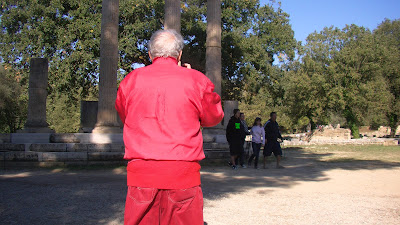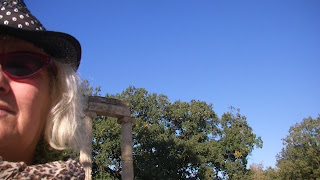The ballpark goes to Greece
Friday
museum at Delphi
The archaeological site of Delphi is one of the most important ancient relics of Greece. The magnitude of the Delphi contributions to the entire ancient civilization cannot be overstated. Many political decisions were taken after consultation of the Oracle, and no colony was founded around the Mediterranean without the consent of the sanctuary at Delphi. In proportion with its immense influence, the settlement at delphi grew from a small village to a imposing depository of fine Architecture and Art.
At the Delphi sanctuary excavations have unearthed settlements that date as far back as the Neolithic era. However evidence of the site's importance dates back to the Mycenaean period (1600-1100 B.C). Most of the ruins that survive today are witness to the site's pinnacle which was reached in the 6th c. B.C., and are testament to the diverse cultural influences that hovered over the sanctuary for a nearly a millennium.
The functions of the Oracle of Delphi grew over the centuries to include athletic games and cultural events and Delphic festivals, the most important of which was the Pythian Games which were held every four years in memory of Apollo's slaying of the Python Dragon. To accommodate the gratitude that each city/state was eager to express, and all the cultural affairs, the sanctuary evolved to include major temple complexes, a theater, a stadium, and a number of ornate treasuries.
Some of the most prominent edifices on the sacred slopes of Delphi are the temple of Apollo, the ancient theater, the stadium, the sanctuary of Athena Pronaia with the Tholos, the Kastalia spring, and the various treasuries that adorn the sacred way. The archaeological museum on the site contains many important ancient Greek artifacts from the excavations at Delphi.
At the Delphi sanctuary excavations have unearthed settlements that date as far back as the Neolithic era. However evidence of the site's importance dates back to the Mycenaean period (1600-1100 B.C). Most of the ruins that survive today are witness to the site's pinnacle which was reached in the 6th c. B.C., and are testament to the diverse cultural influences that hovered over the sanctuary for a nearly a millennium.
The functions of the Oracle of Delphi grew over the centuries to include athletic games and cultural events and Delphic festivals, the most important of which was the Pythian Games which were held every four years in memory of Apollo's slaying of the Python Dragon. To accommodate the gratitude that each city/state was eager to express, and all the cultural affairs, the sanctuary evolved to include major temple complexes, a theater, a stadium, and a number of ornate treasuries.
Some of the most prominent edifices on the sacred slopes of Delphi are the temple of Apollo, the ancient theater, the stadium, the sanctuary of Athena Pronaia with the Tholos, the Kastalia spring, and the various treasuries that adorn the sacred way. The archaeological museum on the site contains many important ancient Greek artifacts from the excavations at Delphi.
the museum at Olympia
The Archaeological Museum of Olympia, one of the most important museums in Greece, presents the long history of the most celebrated sanctuary of antiquity, the sanctuary of Zeus, father of both gods and men, where the Olympic games were born. The museum's permanent exhibition contains finds from the excavations in the sacred precinct of the Altis dating from prehistoric times to the Early Christian period.
the 100 metre dash
The stadium was a holy place for the ancient Greeks, as this is where sporting activities dedicated to Zeus were held. The stadium was originally located within the temenos, with spectators able to view races from the slopes of Mt. Kronos. It was gradually relocated east until it reached its present location in the early 5th century BC. The stadium is connected with the sanctuary by a vaulted stone passageway.
The track is 212.54 m (697.3 ft) long and 28.5 m (94 ft) wide and surrounded by grassy banks on all sides. All the seats were made of mud and on the southern slope there was a stone platform, the exedra, on which the Hellanodikai, the judges, would sit. Opposite this, on the north slope, was an altar to Demeter Chamyne. The stadium could hold 50,000 spectators.
Olympia
Olympia Greece was the site of the ancient Olympic Games, which were celebrated every four years by the Greeks. Olympia was situated in a valley in Elis, in western Peloponnisos (Peloponnesus), through which runs the Alpheus River. It was not a town, but only a sanctuary with buildings associated with games and the worship of the gods. Olympia was a national shrine of the Greeks and contained many treasures of Greek art, such as temples, monuments, altars, theaters, statues, and votive offerings of brass and marble. The Altis, or sacred precinct, enclosed a level space about 200 m (about 660 ft) long by nearly 177 m (nearly 580 ft) broad. In this were the chief centers of religious worship, the votive buildings, and buildings associated with the administration of the games.
Mycenae
The ancient citadel of Mycenae is located in the North-East part of Peloponnese in Argolis, about 1.5 hours away from Athens, and it is an imposing site on top of a rocky hill.
Mycenae was the center of power in the Late Bronze age (1600-1100 BCE), and the excavated ruins that sculpt the top of the rocky hill protected the royal families inside the famous Cyclopean walls. Legend has it that Mycenae was founded by Perseus, and the entire culture of mainlad Greece during the Bronze age was named Mycenaean during the late Helladic period. With its legents, art, and ideas, Mycenean culture reached its zenith from 1300 BCE until 1100 BCE.
Mycenaean culture is the source of ancient epics and legends such as the dynasty of Atreids, the labours of Hercules, the Trojan war, the Thyestian Feast, and Agamemnon's tragic life and death. The surrounding area of Argolis was dominated by many different citadels similar to Myceneae, and during the Bronze Age they took advantage of the geopoliticaly important location to accumulate considerable wealth and poser.
The awe inspiring "Lion Gates" (the earliest known piece of monumental sculpture in the European continent) take you to the interior of the acropolis, and a steep path leads your climb through several ancient buildings and pathways, towards the palace where Agamemnon was murdered by his wife Klytemenestra and her lover after he returned victorious from the Trojan war.
The awe inspiring "Lion Gates" (the earliest known piece of monumental sculpture in the European continent) take you to the interior of the acropolis, and a steep path leads your climb through several ancient buildings and pathways, towards the palace where Agamemnon was murdered by his wife Klytemenestra and her lover after he returned victorious from the Trojan war.
Nafplion
Nafplio was the second capital of newly formed Greece after Misologgi until the capital eventually became Athens. It is an historical city due to its meaning to the Greek Revolution. It has a fantastic centre with small neoclassical historical houses, squares and churches.
It is the capital of the prefecture of Argolida.
It is the capital of the prefecture of Argolida.
Epidavros Museum
This museum exhibits pieces from the Tholos and the temple of Asclepius, gypsum casts from pediments (sculptures by Timotheos), Roman portrait statues, inscriptions, medical and surgical instruments and ex-votos. Many of the Inscriptions are, in fact, prescriptions for medicines and descriptions of cures, valuable texts, without doubt, as far as the history of medicine is concerned and sometimes amusing as well.
Epidavros
Epidavros, south east of Nafplion is well known for the unique acqoustics of its 4th BC century old theater.
Outside the enclosure stood the dwellings of the priests, the doctors, a gymnasium, baths, etc.
To the S.W. of the sanctuary was the 5th century B.C. stadium in which athletic and musical contests were held every four years. At the S.E. end was the Katagogion, by far the largest building in the entire compound. It served as a guest house with no less than 160 rooms for visitors who were healthy. In Roman times, hot baths were added to the faculties available.
Stands to the S.E. and is the best preserved theatre ιn the whole of Greece. It was the work of the architect Polyklitos Junior (4th century B.C.), built of limestone, it can seat 12,000 spectators.
Every summer it comes alive. Attending a performance of ancient drama in this theater is almost a mystical experience. Never to be forgotten. A catharsis of the soul.
At Epidaurus the actors don’t need to shout or speak loudly. The acoustics are so perfect that the merest whisper can be heard in the last row.
Subscribe to:
Comments (Atom)



















































